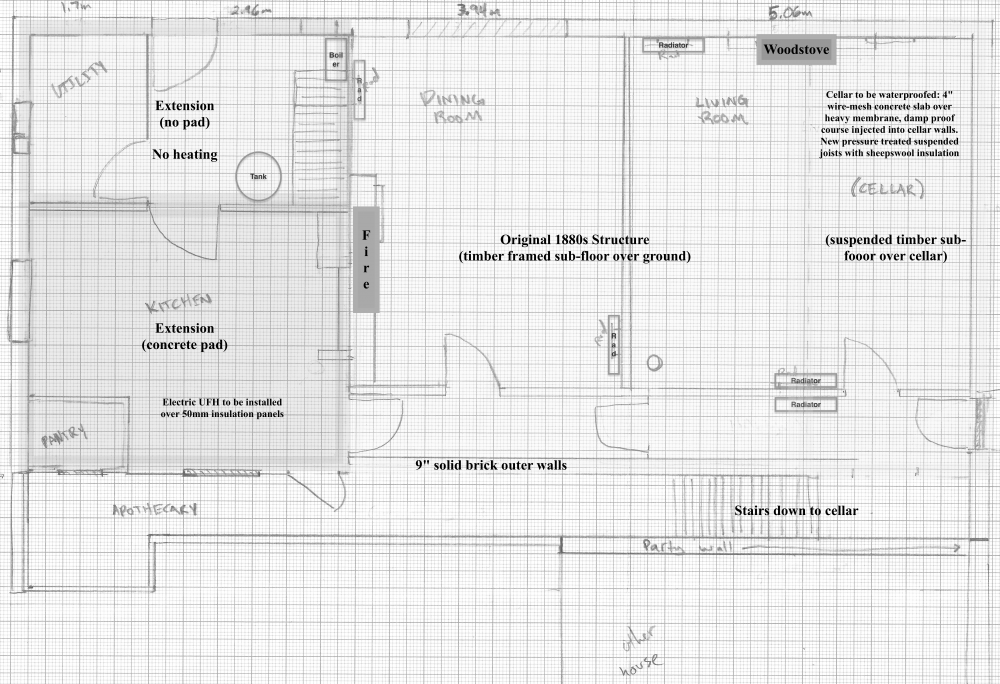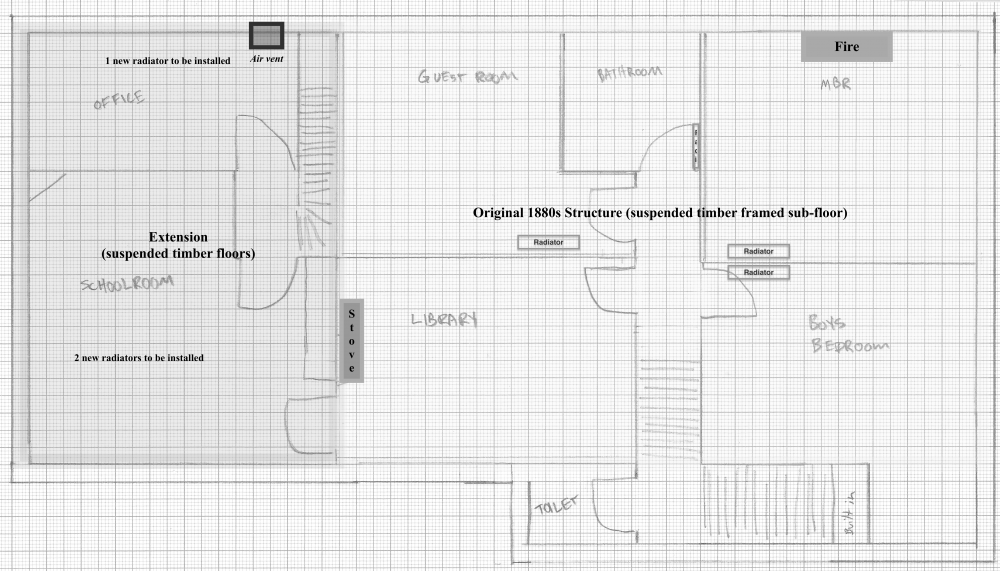Search the Community
Showing results for tags 'victorian'.
-
HI there. I've bought a house which is an Edwardian terrace with a cellar. The rear is a full storey higher ground than the front, due to being on a large hill. COnsequently there's a lot of groundwater moving through the general area and the back of the house is quite damp. The rear room has no cellar below and has a suspended timber floor. I took the floor up in the dampest corner and found a few potential issues. There was almost no sub-floor ventilation as it's full of rubble with one air brick and seemingly no through ventilation to the cellar. But also, there is a clear DPC running about half a brick below the height of the external concreted floor. I've had a surveyor and a structural engineer for various reasons take a look at the place and neither of them seemed that fussed about the DPC being below ground level, but from my research that's a clear and likely source of damp ingress. We run a dehumidifer constantly to see if it will dry out with the boards up and although it keeps the damp smell at bay, the water keeps coming and the dehumidifier fills its reservoir daily. In order to try and improve things I'll be taking out a load of rubble and making a good cross-ventilated sub-floor, but am I fighting a losing battle if I don't sort out the ground level? I have two walls both external in that room and both are raised above the DPC. One was done by the previous owners and one is sadly a shared passage between houses that was renovated by the neighbour without gaining consent.
- 4 replies
-
- damp proofing
- dpc
-
(and 1 more)
Tagged with:
-
I'm renovating an 1880s Victorian semi-detached house. It's largely unmodernised, which means single-paned glass, damp cellar, damp walls, leaky chimney, vented hot water system with a cold water cistern in an overly large closet in the middle of a central first-floor room, unburied electrics etc. The upside is that it's a bit of a blank canvas and I'm looking forward to building up some self-building skills by doing a lot of the work myself. At this point I've browsed forums here and consulted with a few experts and have received some conflicting advice. I'm wondering if some experts on here with some simillar experience might be able to give my current plan a glance and poke holes as appropriate! Images incuded here are hand-drawn (I work on a screen all day, so working with pencil and paper has been therapeautic) but drawn to scale. I've tried to annotate with some indications of underlying structure and heating I have planned. It's a reasonably big 5BR house, about 2k square feet in total, and rather drafty, with as-porous-as-one-might-expect solid 9" brick outer walls. There's also a cellar underneath half the sitting room (indicated on the diagram) with some dry rot in joists and sub-floor I'll be replacing after I can get it properly waterproofed. There's also some damp coming down from chimney in the first-floor room marked library, on which I'll get brickwork repaired and walls replastered. There's a 24kw Worcester boiler feeding 7 radiators. Half the first-floor has no heating at all and seems to have been largely unoccupied for the past several decades. I'm planning to remove gas stoves from the five fireplaces, remove the current 1980s layers, restore the fireplaces to their former glory and install wood-burning stoves in several of them. I'm aware there are differing opinions about stoves, but I'm pretty set on installing at least 2-3 of these. It's worth noting that sustainability is a key concern for us, so I'm not tied to the idea of offsetting costs invested in the heating system with energy bill savings 1:1. I do want to balance outlays across the different elements of the house, so can't dump £10k into an exotic hot water system or GSHP, but getting off fossil fuel inputs as much as possible is a key concern, thus my plans to install solar thermal or an ASHP eventually alongside use of biomass in the woodstoves. My provisional plan for the (21x8') cellar is to excavate to get a flat floor (there's a good bit of rubble and the remnants of old brick flooring), put in a heavy membrane, 2" or so of sand and then a 4" wire-mesh reinforced concrete floor. I'll inject a damp-proof course into the walls, tank the whole thing, and to improve air flow put in a moisture extractor and probably also a humidifier to get moisture in there under control. I'll have zigbee / wifi humidity & temp sensors in all the rooms, so I will be able to monitor progress on this with some level of precision. I'm thinking we'll remove the radiator from the kitchen, which is the "indoor" part of an extension which has a concrete pad installed, and replace with electric UFH on top of 50mm insulation boards. Above the extension on the first floor are two rooms without heating installed. There I'm thinking I'll install a few radiators. Plan for bathroom upstairs is to completely gut and replace the bathroom upstairs, and install a thermostatic mixer shower and an electric towel heater style radiator. One key question is how to drive the heating in this overall design. On one hand, it seems like the most efficient choice would be to put in an unvented hot water cylinder (250l) and have a plumber replace the hot water plumbing to be a 22mm pressurised system. I've seen good advice on here to get extra insulation installed and it seems like I'll probably get a Telford cylinder and get an extra 50mm of insulation added to minimise thermal loss. I'm also thinking I'll get a cylinder with connections for thermal solar as I will probably add solar PV and thermal water heating when we replace the slate roof in 3-5 years. But I'm also wondering if it may be better to install a thermal store. They seem reasonable in cost, and also a bit easier to add in new inputs for heat. Ideally, I will add thermal solar and perhaps get boilers which feed in from the wood-burning stoves to store energy being generated while they are running. Hot water demand will be moderate - one bath a day for the kids and two showers for adults, which can be spaced out. There are five sinks in the house and the usual appliances. I don't need a million gallons per minute coming out of the shower, but do want to get away from the many years of combination boilers in the houses we've occupied which get cold every time someone turns on a sink. In terms of insulation overall, I've got insulation in the ground floors as a mix of insulation boards in kitchen and sheeps wool (probably in the main rooms). I'll add a bunch of mineral or sheeps wool to the roof to get that up to 330mm. And we'll replace all the windows with proper double paned. I am also wondering if, since we'll be renovating all the walls and floors and the house will be unoccupied while I do initial work, if it would be worthwhile to install internal wall insulation. This seems to be a bit expensive, and time consuming. It seems like the green home grants aren't coming any time soon to Wales either. I'm resigned to the fact that it is unwise to convert a Victorian solid wall home to a passivehaus, but also wondering if this might, conversely, be a good way to get away from that "cold drafty house feeling". If anyone on here has done internal wall insulation as part of a renovation, I'd love to hear more about how it worked for you, especially in terms of wall dampness and overall warmth improvement. Sorry for any rookie errors here - I'm still definitely learning how these systems all work together and thanks to anyone who has wisdom to share. I'm also happy to share photos of the house if that's useful.
- 25 replies
-
- damp
- waterproof
- (and 7 more)
-
Hi I've recently purchased a 1bed "colony" house in Edinburgh. For those unfamiliar with colony houses, these were homes built throughout Victorian Edinburgh and were designed as homes for the skilled working class, more details about them here if you are interested. Mine is a 1 bed ground floor, 45sqm altogether, with a small front and back garden. It's currently fitted with electric storage heating that I am hoping to remove and replace with a small air source heat pump and install underfloor heating throughout. I found this forum through my ASHP researching and have found it really useful so far. I also want to change the internal layout, so the largest rooms are for the kitchen and living room. I wish to move the bathroom to the opposite side of the house and turn the current kitchen (small, narrow) to a very small double bedroom! This requires a couple of walls knocking down and rebuilt. I won't have the keys to the property until late November so works can't start yet but I'm trying to do as much research before then. Thanks all, looking forward to asking lots of questions as I have them...!
-
Hello, I'm new to the forum, will soon have a house in need of insulation... Will post my questions in the relevant forum!
- 7 replies
-
- victorian
- insulation
-
(and 3 more)
Tagged with:



